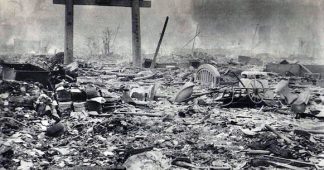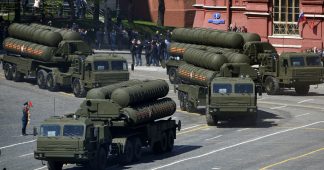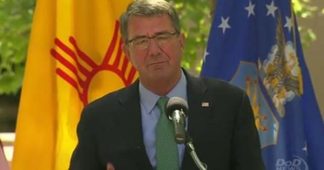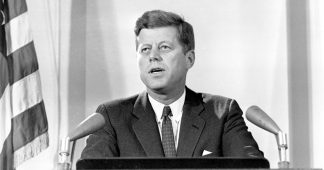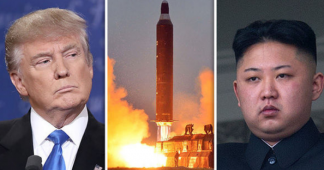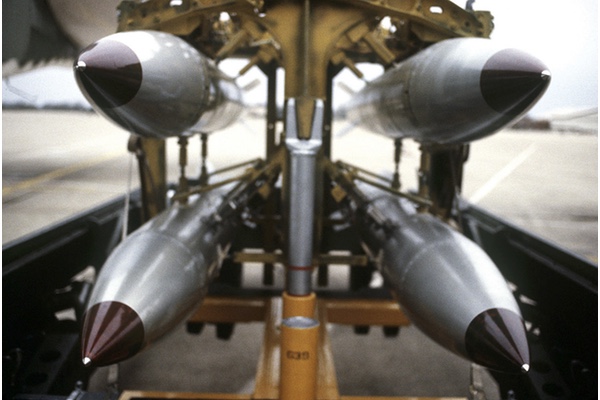April 5, 2017
This Madness Deserves a Protest: an Inside Account at US Nuclear Weapons Strategy
“In contrast to the Soviet Union, the United States has always maintained its ‘right’ to carry out a nuclear first strike. This has never changed and was reaffirmed by Defense Secretary Ashton Carter . . . on September 27, 2016.”
— Diana Johnstone, From MAD to Madness.
There is not much hope for the retraction of this threat. On March 21, Reuters reported “Trump has said that while he would like to see nuclear weapons abolished, he wants the United States to have an unrivaled arsenal. He also said that the United States has ‘fallen behind’ in its nuclear capabilities, even though it is in the midst of a 30-year, $1.3 trillion drive to modernize what most experts agree is the world’s most powerful nuclear force.”
An insider’s memoir, From MAD to Madness, by Paul H. Johnstone, describing the persistence of the US nuclear threat has recently been published by Clarity Press. Johnstone was a senior analyst in the Strategic Weapons Evaluation Group in the Department of Defense, directing studies on the probable consequences of nuclear war, to us and to them, and also an author of The Pentagon Papers. He died in 1981, leaving his memoir to his daughter, author (and CounterPunch contributor) Diana Johnstone. He had previously served in World War II as an evaluator of Japanese enemy targets, but as Diana says here: “Hiroshima changed the nature of targeting dramatically, and that is the story my father tells in his memoir.”
In this book Diana has finally published his “Memoir of a Humanist in the Pentagon,” along with her added commentary and a foreword by Paul Craig Roberts. Roberts expresses in a nutshell the contemporary horrific relevance of the book: “The neoconservatives in pursuit of their goal of US world hegemony have resurrected the possibility of nuclear war. The neocons have taken us from MAD to madness.”
The neocons are not some far-right fringe group; they represent the mainstream of US foreign policy in recent Democratic and Republican administrations. The political use of the nuclear threat has a long history. It was inaugurated by the nuclear bombing of Hiroshima and Nagasaki, a political decision opposed by the military. Admiral Leahy, Chairman of the Joint Chiefs of Staff wrote: “the use of this barbarous weapon at Hiroshima and Nagasaki was of no material assistance in our war against Japan. The Japanese were already defeated and ready to surrender. . .” The Truman Doctrine (1947) indicated that there were no regrets. It stated in effect that any country that appeared to be adopting a communist form of government, whether through outside intervention, civil war, or ordinary elections, would be subject to whatever punishment the United States chose to inflict, not excluding nuclear attack.
Johnstone traces the “breather” in our policy characterized by MAD—the idea that Mutually Assured Destruction: a path to mutual suicide—was a deterrent to the use of nuclear weapons. This realization by our government occurred once Soviet nuclear capability became obvious. However, as Roberts notes, after the Soviet collapse in the 1990s the US “resurrected nuclear weapons as usable weapons of war. The Obama regime . . . authorized a trillion dollar expenditure for nuclear weapons, and US war doctrine elevated nukes from a retaliatory role to pre-emptive first strike.” Roberts, who was United States Assistant Secretary of the Treasury for Economic Policy under President Reagan in 1981, maintains that Reagan and Gorbachev “eliminated the risk of Armageddon by negotiating the end of the Cold War.”
Johnstone’s exposition of US nuclear policy is sobering, and his special vantage point as an insider is a revelation about how foreign policy is concocted. The conclusions and the process are both astonishing.
Although the Cold War, often hot, was fought in many parts of the world, Johnstone’s main task was to assess the consequences of nuclear war with the Soviet Union. Its probability was not a major concern for the analysts; plenty of those on our side were raring to use this super weapon.
Johnstone worked with the assistance of many teams, task forces, and committees. He noted that among those charged with divining Soviet intentions, few had any expertise on the subject: “Kennan was shunted aside. . . as insufficiently anti-Soviet.” State Department analysis or research was rarely seen or considered significant by the military or White House representatives on the committees. “Kennedy. . . seems to have depended far more on his longstanding, seat-of-the-pants notions of how to interpret Soviet intentions.”
“Almost never was there any suggestion that Soviet arms were in any way defensive, or that the Soviets feared us.” A related insider study of the decision-making process in the Kennedy White House is James C. Thomson, Jr.’s “How Could Vietnam Happen? An Autopsy.”
At the time (and now, in spades) intelligence sources were multiplex. Each of the military branches had its own intelligence division, in addition to outside contractors. There were also the agencies of the State Department, the CIA and the NSA; spies working for the Commerce and Agriculture Departments; overseas (especially Latin American) operations of the FBI; and “debriefings” of anyone who had traveled to any sensitive area, including exchange students and professors, journalists, the burgeoning INGO (International Non-Governmental Organizations) crowd, and real or fake businesspeople. In the confusion, the information that reached the senior operational people was determined by biases all along the way, including assumptions about what the President wanted to hear. An eloquent recounting of how fantasies were substituted for accurate information about Southeast Asia can be found in Ralph McGeHee’s Deadly Deceits.
Interservice rivalries influenced the strategy envisioned for a future war. At first the Air Force had a near monopoly on weapons, so the Army advocated for conventional warfare.
Later, all branches had nuclear delivery systems, and competing for budget allocations, advocated their use. An addition to the Navy’s arsenal was very recently announced: “The US preemptive nuclear strike capability has significantly grown. The strategic nuclear forces modernization program has implemented new revolutionary technologies to vastly increase the targeting capability of the US submarine-launched ballistic missile (SLBM) arsenal.”
In the post-WWII period, despite all the analysts recruited for this task, there was great uncertainty in all the calculations of damage to the economic base, civilians, and the very structure of a society targeted with nuclear weapons. Assumptions were often made on the basis of earlier wars, where destruction of factories and resources was intended to disable armament production. Before nuclear weapons, the theory was that wars could be fought and won by this type of strategic bombing. However, after a nuclear attack, the military, political, and environmental consequences of initial radiation and continuing fallout, with or without shelters, could never be determined; only imagined.
Nevertheless, the military advisors on the committees had a hunch that a pre-emptive strike to destroy the USSR would be the least destructive option, so their hearts were  in it. They assumed that a nuclear exchange would create millions of casualties in the US, but that “the US would continue to exist as an organized and viable nation, and ultimately would prevail, whereas the USSR would not.”
in it. They assumed that a nuclear exchange would create millions of casualties in the US, but that “the US would continue to exist as an organized and viable nation, and ultimately would prevail, whereas the USSR would not.”
Much more attention was paid to the prospect of nuclear annihilation of the Soviet Union than the consequences of an initial or retaliatory attack on the United States. Johnstone’s sober view was that any issue that precipitated a war would be dissolved by the ensuing devastation; there could be no victor in a nuclear war.
Johnstone includes two case studies in which his Weapons Systems Evaluation Group participated: the Laos Crisis of 1960-1961 and the Berlin Crisis of 1961. In the case of Berlin, plans were prepared for stages of retaliation all the way to nuclear war in anticipation of the USSR interfering with traffic from the West into Berlin on the Autobahn. The Soviets had been requesting identification or delaying document checking in ways that the US considered unwarranted. These “microaggressions” were interpreted as merely a prelude to a showdown. As an additional indication of our resolve to protect our access to Berlin, the Joint Chiefs of Staff suggested that we should go to war in Southeast Asia.
At no time during these crises, or in the planning for nuclear war, did Johnstone note any concern by committee members for international law, not only its prohibitions, but also its many mechanisms for resolving disputes. War had been outlawed by the Kellogg-Briand Pact in 1928. The Charter of the United Nations, a ratified treaty commitment of the US, prohibits war as an instrument of foreign policy; even the threat of war is an international crime.
Article 2, Section 4: All Members shall refrain in their international relations from the threat or use of force against the territorial integrity or political independence of any state, or in any other manner inconsistent with the Purposes of the United Nations.
Customary international law prohibits any weapon that does not discriminate between civilians and combatants. This was used by the International Court of Justice in its 1996 advisory opinion on the use of nuclear weapons:
It follows from the above-mentioned requirements that the threat or use of nuclear weapons would generally be contrary to the rules of international law applicable in armed conflict, and in particular the principles and rules of humanitarian law.
However, in view of the current state of international law, and of the elements of fact at its disposal, the Court cannot conclude definitively whether the threat or use of nuclear weapons would be lawful or unlawful in an extreme circumstance of self-defence, in which the very survival of a State would be at stake.
The Treaty on the Non-Proliferation of Nuclear Weapons, 1970, requires nuclear-weapon countries to undertake progressive nuclear disarmament toward the goal of complete elimination of nuclear weapons. This is not the direction being followed by the US, among other signatories.
Johnstone began his federal service in 1937 as a historian in the Department of Agriculture, and Diana notes that his career mirrored the changes in the US economy: “America turned from farming to bombing as the basis of its industrial economy. . .” Yet the Cold War itself, although tragically affirmed by the nuclear bombing of Japan, has a much longer history (some say it started in 1848), and includes US and allied participation in the “hot” invasion of the USSR after the 1917 Revolution and the US corporate assistance during the 1930s in creating Hitler’s war machine. This buildup proceeded apace, with the participation of the great US corporations. During the same period, the President exercised a Congressional mandate to prohibit arms trades that supported war. It was imposed on a US corporation, Curtiss-Wright, selling arms to Bolivia for its border war against Paraguay: the Chaco War. As it turned out, that was not the greatest threat to world peace.
Johnstone believed that our Cold War policies were irrational, and that we could have made friends with the anti-colonial, nationalistic revolutionary movements that our “anti-Communist obsession . . . led us to oppose.” Maybe it is a question of who is “us”?
The vast population of the US, rich in resources, inventiveness, and skilled labor could easily have co-existed with socialist societies, intent on self-development and willingly engaging in fair trade. Multinational corporations, however, were challenged by nations that wanted to expel their oil rigs, gold miners, sweatshops, cigarettes, pesticides, telephone services, chemical factories, waste dumps, and even innocent Coca-Cola.
The military and the increasingly gigantic industries equipping it wanted bases everywhere, and somewhat plausible threats that would justify annual upgrading of the lethal arsenal. Wars now and then that would enable testing and destruction of weapons were also useful for the advancement of warriors and profits of contractors. Furthermore, revolutions that were allowed to succeed and improve the lives of people might create imitators in our land of vast wealth accompanied by astounding poverty and misery.
Yet neither Roberts nor Johnstone discusses the role of multinational corporations and the military-industrial complex in motivating and perpetuating the post-WWII Cold War. They attributed major influence on US policy to anti-Soviet émigrés (Kissinger, Brzezinski and others) from Eastern Europe. A high-level Air Force intelligence “Special Studies Group,” headed by a Hungarian émigré “expert” predicted in every annual appraisal that there would be “a massive Russian land attack on Western Europe the following year.”
The worldwide cold war between capitalism and socialism continues—in Cuba, among other places—and there is now also the megalomaniac goal of world hegemony. The projected attack by the now-capitalist Russia is still awaited, despite indications that the Russians want to eliminate the specter of civilization’s total nuclear destruction. Johnstone’s sober prediction in From MAD to Madness: “there can be no victor in a nuclear war” must be given priority by the newly-awakened activists. The abolition of nuclear weapons would be a step towards sanity.
